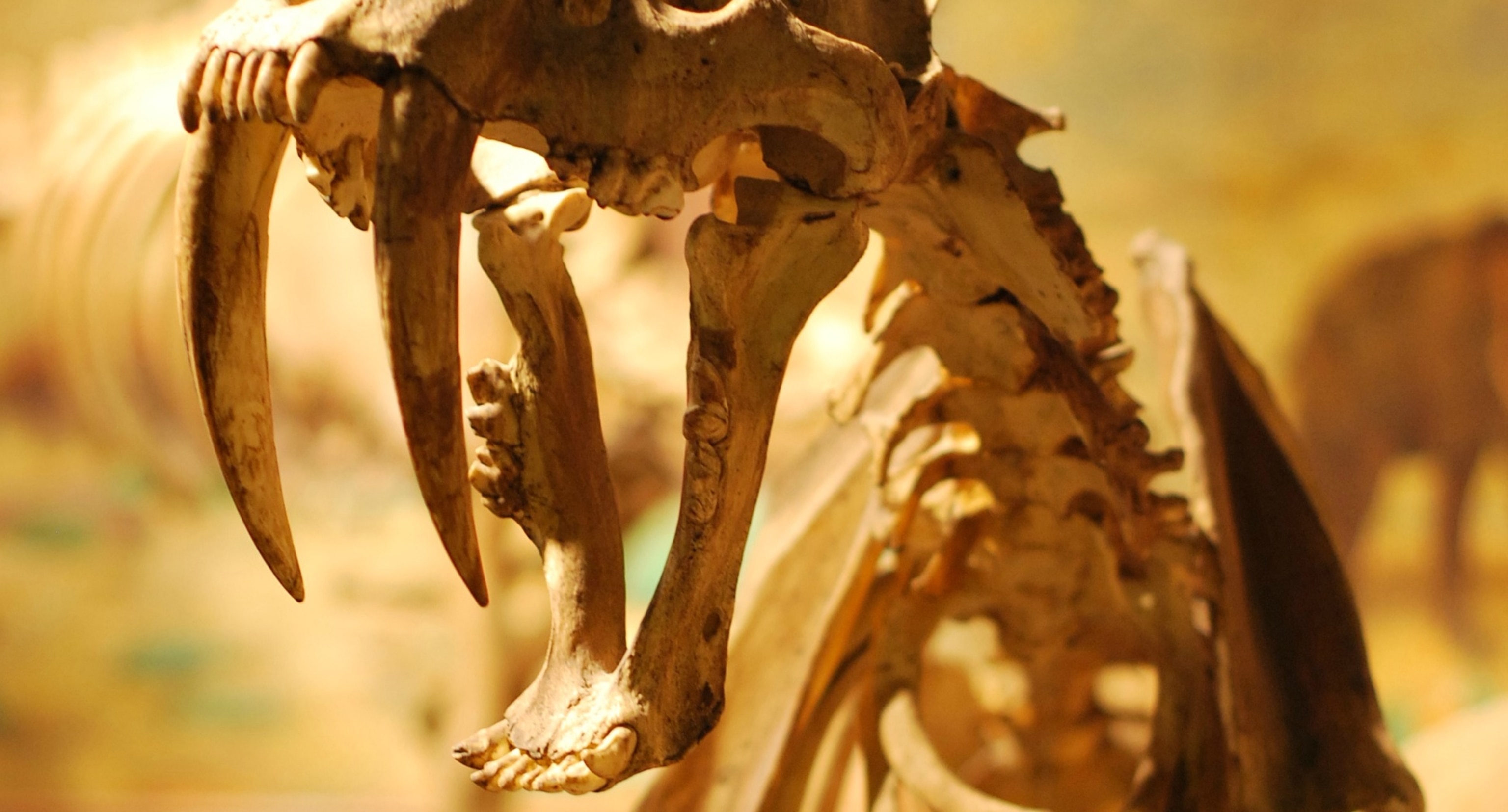There are no sabercats alive today. The clouded leopards of Asia come close, but even their long canines look dainty in comparison to the extended teeth of the last true sabertooths. And even though humans undoubtedly saw and lived alongside sabercats, no one recorded how the big cats fed or why they died out. The hyper-fanged felids have only been extinct for about 10,000 years, yet their biology and disappearance remain oft-debated mysteries. A new study of microscopic damage preserved on sabercat teeth only makes their lives and ultimate extinction all the more perplexing.
Smilodon fatalis is practically synonymous with California’s La Brea asphalt seeps. The tar has yielded more remains of Smilodon here than anywhere else in the world, and the abundant cat was just one species in a wider cast of carnivores and now missing-megafauna. Indeed, while Smilodon was an imposing predator, its rarer neighbor the North American lion – Panthera atrox – was a bit larger.
Both cats died out around the same time. Their demise has traditionally been tied to the disappearance of the mammoths, mastodons, giant ground sloths, and other megamammals. Climate change, human hunting, or a combination of the two drove North America’s Ice Age giants into oblivion. Predators who relied on massive amounts of mammoth meat followed suit.
Previous studies of La Brea’s cats seemed to confirm this hypothesis. Broken Smilodon and American lion teeth hinted that these cats were cracking open the bones of their prey to make the most of relatively rare kills – unusual behavior for cats, who typically favor soft-tissue. Chipped canines and damaged teeth indicated that the predators were struggling towards the end of the Pleistocene, and at some point there was simply not enough meat to go around.
But patterns of microscopic wear tell a different story. Today in PLoS One, Vanderbilt University paleontologist Larisa DeSantis and colleagues report that both Smilodon and the American lion were not quite so stressed as earlier studies supposed. By comparing the dental topography of scratches and pits on the molar teeth of extinct cats with the micro-damage on the teeth of modern cheetahs, lions, and spotted hyenas – carnivores with known dietary preferences – the researchers were able to outline the feeding habits of the sabercat and American lion. The results contradict what paleontologists have often thought about these cats.
Despite being an extinct cousin of today’s lions, Panthera atrox apparently ate like a cheeth. The damage on the extinct cat’s teeth indicated that it eschewed chewing on bones. Yet many American lion specimens – about 36% of those found so far – have broken canine teeth. The reason for this difference, DeSantis and coauthors suggest, is that the microwear patterns record how the lions processed carcasses, while broken teeth underscore how the cat killed prey. Considered to be a solitary predator, Panthra atrox may have been a large herbivore specialist – the lion didn’t have to share the soft parts of its kills, but suffered a greater risk of breaking its piercing canines when trying to subdue victims.
Smilodon fatalis teeth show a different pattern. Not as many sabercat skulls have broken canines, but their molar teeth show a constellation of pits and scratches somewhere between that of modern lions and cheetahs. Based on the results presented by DeSantis and collaborators, Smilodon probably gnawed bones more often than the American lion and preferred slightly smaller prey.
Sabercats in general, and Smilodon in particular, have often been characterized as specialists who used their fangs on mammoths and other exceptionally-large Pleistocene herbivores. Yet a study of sabercat bites published last year by Ki Andersoon and colleagues, as well as the dental results in the new study, suggest that Smilodon probably targeted horses, camels, bison, and other mid-sized herbivores. Going after slightly smaller prey posed less of a risk to the cats’ characteristic teeth, and, if Smilodon really was a pack hunter that shared carcasses, then a little less meat would have to stretch further to feed a pride. Social Smilodon may have had to chew more bones to make the most of a kill.
Of course, the La Brea seeps include multiple pits of different ages. When DeSantis and colleagues compared Smilodon and American lion tooth wear through time – between about 35,000 to 11,500 years ago – they didn’t find any hint of increasing bone-cracking. The patterns of wear remained relatively consistent for thousands of years, and, in fact, the last American lions appears to be crunching even fewer bones than earlier lions in the same area. Contrary to prior proposals, life at La Brea wasn’t becoming harder over time.
Based upon the dental record, the last Smilodon and American lions were not suffering from a lack of prey. The cats killed and chewed prey as they had for millenia prior. Then why did they disappear?
Had the cats been in a gradual decline, humans and climate change winnowing away at prey stocks, we could easily comprehend why these two great felid lineages were snuffed out. The emerging picture is not so neat. And the more we learn about these cats and their Ice Age habits, the more deeply we feel their absence in the modern world. Smilodon and Panthera atrox would not be out of place among America’s western expanses. The confounding question is why they have gone missing.
References:
Andersson, K., Norman, D., Werdelin, L. 2011. Sabretoothed Carnivores and the Killing of Large Prey. PLoS ONE 6,10: e24971. doi:10.1371/journal.pone.0024971
DeSantis, L., Schubert, B., Scott, J., Ungar, P. 2012. Implications of Diet for the Extinction of Saber-Toothed Cats and American Lions. PLoS ONE 7, 12: e52453. doi:10.1371/journal.pone.0052453

